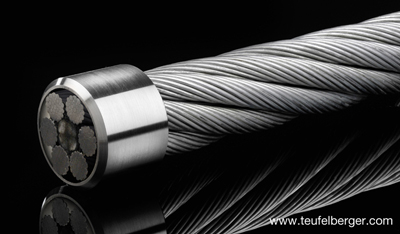SOLITEC®, recently unveiled at the Interalpin 2011 Trade Show in Austria, is TEUFELBERGER‘s latest generation of round strand ropes. It stands for SOLId TEChnology, that is, long service life, minimal initial elongation, and highest flexibility. Ultimate traveling comfort and quietest operation are the result of a refined, innovative manufacturing process that has allowed TEUFELBERGER’s engineers to largely cancel out a rope’s initial elongation as early as in the production stage.
Plastified lubricated steel cores generally increase the life span of offshore crane ropes. That is the reason why the product portfolios of all major manufacturers of high-performance steel wire ropes also feature ropes that incorporate this technology.
Steel wire rope specialist Teufelberger has already been using plastic-covered steel cores for several years.
Plastification has a positive impact on a rope’s life span in two different ways. Firstly, the compact plastic cover acts like a cushion between the rope’s inner portion and its outer strands. Secondly, this technology effectively blocks the ingress of water into the core.
When the rope is tensioned, all strands will be stretched accordingly. As the helix of the outer strands gets longer, their diameter decreases. Hence, the rope’s inner portion is subjected to lateral compression.
This is where the Plastfill core comes in. It causes punctiform pressures to be distributed across larger areas and, in this way, eases the contact pressure per unit area exerted on the wire. This reduces stress concentration and, as a result, enhances the rope’s service life.
In use, ropes are not only tensioned but also exposed, on a daily basis, to repeated bending stresses while running over sheaves or subjected to high lateral pressures in multilayer spooling.
In this connection, Plastfill cores offer another advantage: when running over sheaves, there is relative movement of the wires and strands. Internal wear frequently results in fretting corrosion that shortens the rope’s service life accordingly. Lubricating the steel core and surrounding it with a compact plastic cover in order to keep the lubrication intact helps to reduce fretting corrosion in the rope’s inner portion. Furthermore, by embedding the outer strands in the plastic cover, it is possible to position the strands accurately, which in turn ensures the consistent spacing of the strands in a vault-like configuration. This is of particular importance for multilayer spooling where ropes are exposed to high lateral pressures.
This optimised construction features the stabilized strand structure ensured by the Plastfill core. It helps distribute the pressure evenly onto all strands and, as a consequence, enhances the stability to lateral pressures of the special-purpose steel wire rope made by Teufelberger.
Another important aspect for use in offshore environments is water-induced corrosion. Teufelberger Plastfill technology relies on special plastic materials that do not absorb water. This helps to reduce the risk of internal corrosion and minimizes the risk potential in the area that cannot be inspected visually.
As has already been mentioned above, Teufelberger’s Plastfill technology optimizes the frictional situation. Therefore, it achieves greater breaking strength than comparable steel wire ropes without plastic covers, in both Q-ropes (non-rotation-resistant ropes) and TK-ropes (rotation-resistant ropes).
Plastfill is a technology where the steel core is surrounded by a compact plastic cover. Not only does this technology increase the rope’s service life, but it also enhances its breaking strength.
TEUFELBERGER is the only manufacturer of ropeway ropes to strand all of its SOLITEC®ropes with preformed plastic support strands (support profiles) arranged between the strands. This permits the perfectly even distribution of the strands in the rope – without allowing contact between them. Hence, these support profiles help to permanently avoid the consequences of contact between strands such as corrosion and wire breakage. The vibration-damping trapezoidal plastic support profiles are also used across the entire splicing zone in order to ensure perfect and consistent quality without weak spots throughout the entire length of a rope. In addition, the support profiles slide easily on top of the surface of the plastic insert, which, as the rope undergoes many flexing motions, has a very positive impact on its life span.
Another feature of the SOLITEC® technology is the proven, long-standing braided and greased fiber insert which is overmolded with a compact plastic cover. During the stranding process, the cold strands are pressed into the plastic insert. This helps achieve the perfect roundness of the insert and, at the same time, ensures its extremely high resistance to tensile forces. Hence, a SOLITEC® insert cannot tear or break.
Source:



